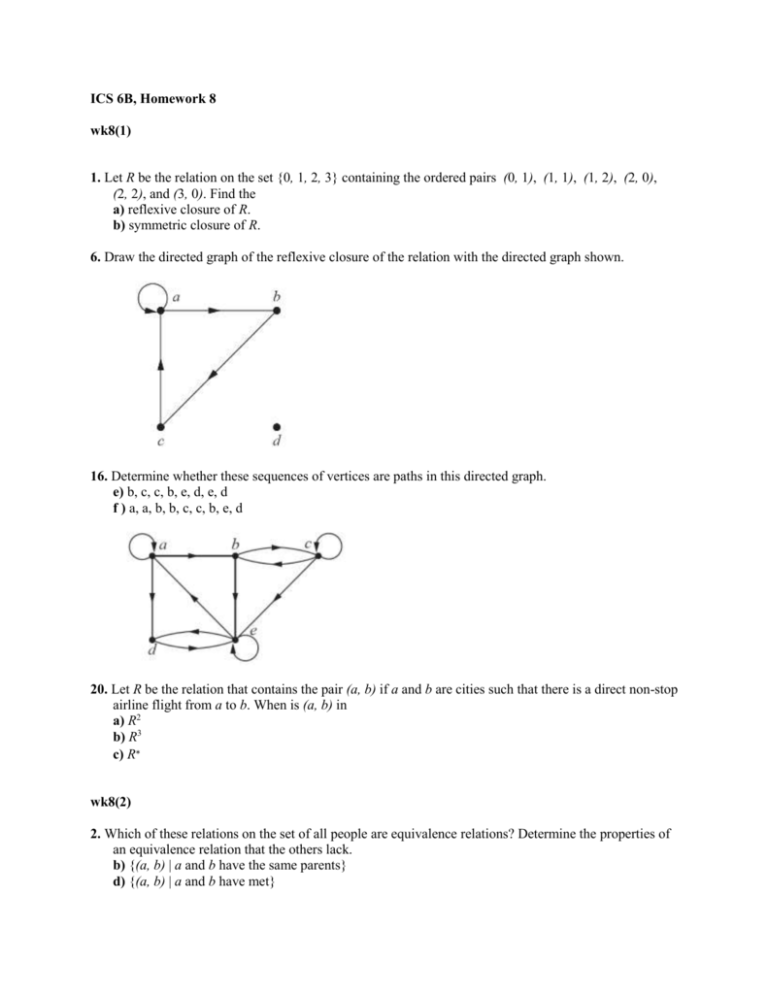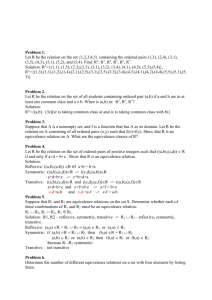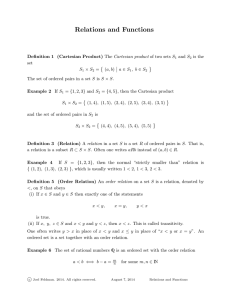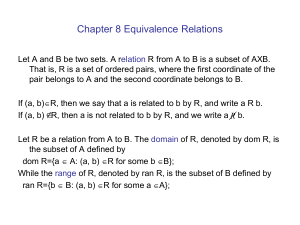ICS 6B, Homework 8 wk8(1) 1. Let R be the relation on the set {0, 1
advertisement

ICS 6B, Homework 8
wk8(1)
1. Let R be the relation on the set {0, 1, 2, 3} containing the ordered pairs (0, 1), (1, 1), (1, 2), (2, 0),
(2, 2), and (3, 0). Find the
a) reflexive closure of R.
b) symmetric closure of R.
6. Draw the directed graph of the reflexive closure of the relation with the directed graph shown.
16. Determine whether these sequences of vertices are paths in this directed graph.
e) b, c, c, b, e, d, e, d
f ) a, a, b, b, c, c, b, e, d
20. Let R be the relation that contains the pair (a, b) if a and b are cities such that there is a direct non-stop
airline flight from a to b. When is (a, b) in
a) R2
b) R3
c) R∗
wk8(2)
2. Which of these relations on the set of all people are equivalence relations? Determine the properties of
an equivalence relation that the others lack.
b) {(a, b) | a and b have the same parents}
d) {(a, b) | a and b have met}
16. Let R be the relation on the set of ordered pairs of positive integers such that ((a, b), (c, d)) ∈ R if and
only if ad = bc. Show that R is an equivalence relation.
22. Determine whether the relation with the directed graph shown is an equivalence relation.
26.c) What are the equivalence classes of the following equivalence relation {(0, 0), (1, 1), (1, 2), (2, 1),
(2, 2), (3, 3)} on the set {0, 1, 2, 3}?
40.a) Let R be the relation on the set of ordered pairs of positive integers such that ((a, b), (c, d)) ∈ R if
and only if ad = bc. What is the equivalence class of (1, 2) with respect to this relation?
42. Which of these collections of subsets are partitions of {−3,−2,−1, 0, 1, 2, 3}?
a) {−3,−1, 1, 3}, {−2, 0, 2}
d) {−3,−2, 2, 3}, {−1, 1}
wk8(3)
2. Which of these relations on {0, 1, 2, 3} are partial orderings? Determine the properties of a partial
ordering that the others lack.
d) {(0, 0), (1, 1), (1, 2), (1, 3), (2, 0), (2, 2), (2, 3),(3, 0), (3, 3)}
e) {(0, 0), (0, 1), (0, 2), (0, 3), (1, 0), (1, 1), (1, 2), (1, 3), (2, 0), (2, 2), (3, 3)}
6. Which of these are posets?
a) (R,=)
b) (R,<)
c) (R, ≤)
d) (R, ≠)
8.a) Determine whether the relation represented by the zero–one matrix is a partial order.
101
[ 1 1 0]
001
10. Determine whether the relation with the directed graph shown is a partial order.
22. Draw the Hasse diagram for divisibility on the set
a) {1, 2, 3, 4, 5, 6}
d) {1, 3, 9, 27, 81, 243}
32. Answer these questions for the partial order represented by the Hasse diagram shown.
a) Find the maximal elements.
b) Find the minimal elements.
c) Is there a greatest element?
d) Is there a least element?
e) Find all upper bounds of {a, b, c}.
f ) Find the least upper bound of {a, b, c}, if it exists.
g) Find all lower bounds of {f, g, h}.
![MA1124 Assignment3 [due Monday 2 February, 2015]](http://s2.studylib.net/store/data/010730345_1-77978f6f6a108f3caa941354ea8099bb-300x300.png)










